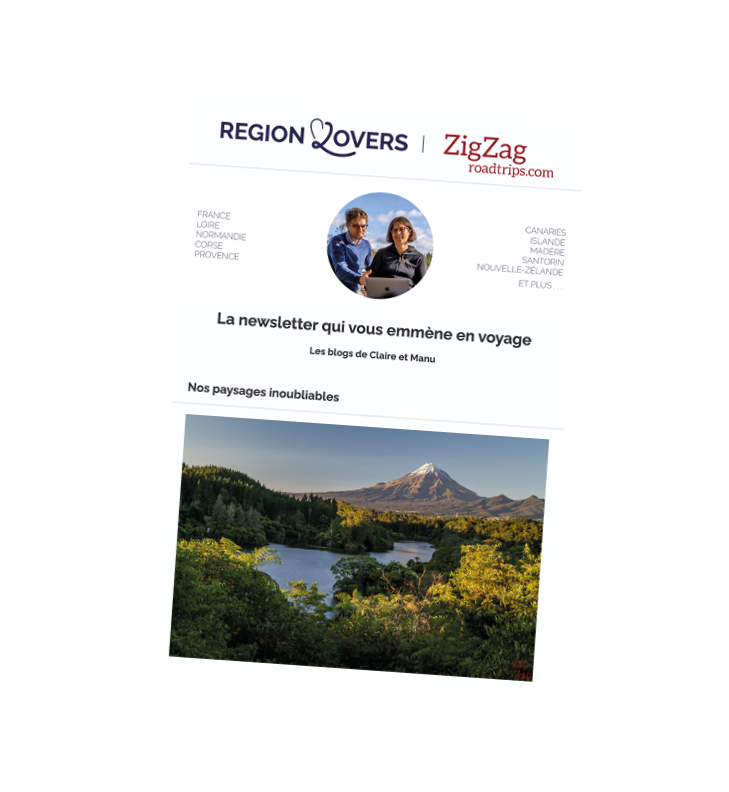Are you passionate about the history of D-Day or simply curious? Visiting Omaha Beach was a memorable experience for us.
Located along the Normandy coast in Calvados, Bloody Omaha is the most famous D-Day beach, because it was so deadly. We took the opportunity to visit the American Cemetery overlooking the beach, and other commemorative sites nearby.
In this article, we share with you the 10 must-do activities on the beach, based on our experience and our photo tips.
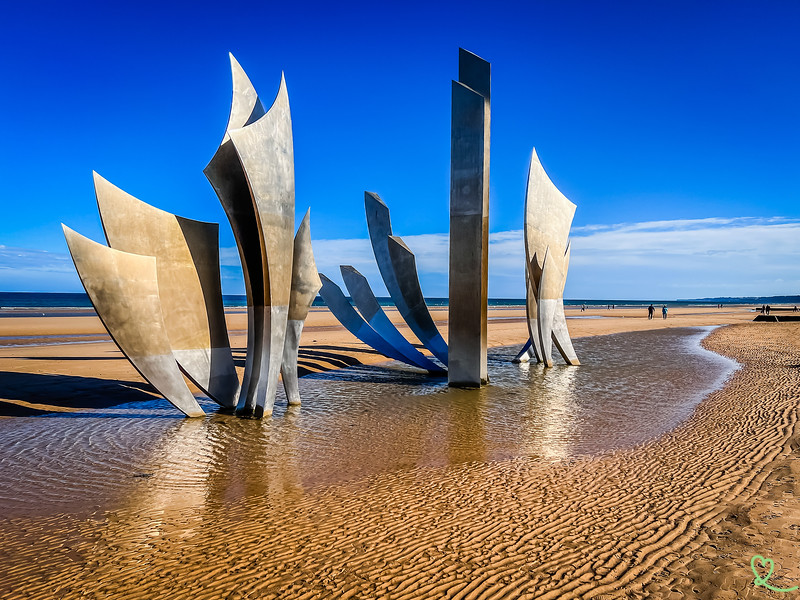
This review is completely independent, we visited anonymously and paid our entrance tickets in full.
The Landing at Omaha Beach – introduction
D-Day and the role of Omaha Beach
But what was the role of Omaha Beach? It was one of the beaches where Allied forces, mainly American troops, landed in Normandy. However, the assault on Omaha Beach was particularly difficult due to natural obstacles and formidable Nazi defenses. The American soldiers encountered major difficulties due to intense enemy fire and the topography of the terrain. Despite this, thanks to their courage, determination and the support of amphibious troops, they finally succeeded in securing the beach, albeit with heavy losses. That’s why it’s known as “Bloody Omaha“.

What to see in Omaha Beach
Today, you can see the beach and its famous sculpture, as well as numerous D-Day museums and memorials. We list them below.
You’ll soon have access to a short video listing the must-do activities on Omaha Beach.

Practical tips and map: Omaha Beach, Normandy, France
Omaha Beach is a large beach bordering several communes in Normandy: Sainte-Honorine-des-Pertes, Colleville-sur-Mer, Saint-Laurent-sur-Mer and Vierville-sur-Mer. It is located in the Calvados department in Normandy. The American Cemetery overlooks this D-Day beach.
Where is Omaha Beach?
- Driving time from Rouen: 2h,
- Driving time from Bayeux: 25min,
- Driving time from Caen: 45min
- Driving time from Deauville: 1h25,
- Driving time from Cherbourg: 1h,
- Driving time from Paris: 3h20.
Here is a map to help you find your way:
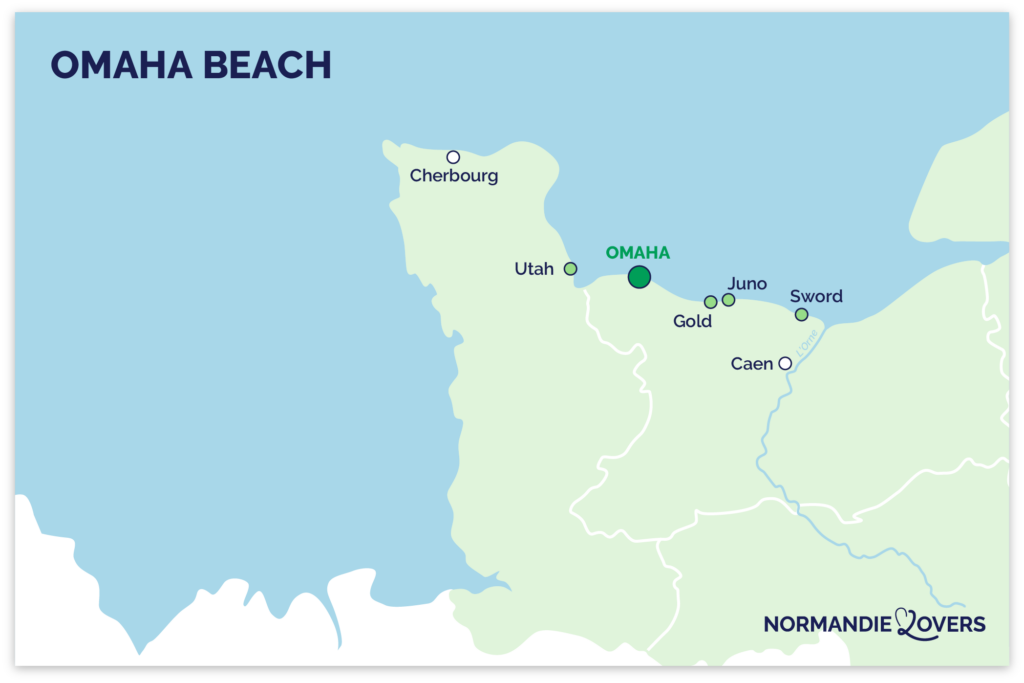
How to get there From Paris, Caen or Bayeux
- By public transport: difficult access, train to Bayeux then Nomad bus line 120 to the cemetery.
- Guided tour from Bayeux – see program and availability.
- Guided tour from Paris – see program and availability.
- By car: the easiest way to visit everything, access via the N13 trunk road. The beach and cemetery are well signposted.
OUR ADVICE FOR RENTING A CAR IN Normandy
- Compare prices on our preferred platform: DiscoverCars – one of the best rated sites.
- Choose a car that is comfortable enough (distances can be long) but compact (some parking lots and villages are narrow).
- Think of thecomplete insurance (some roads are tortuous and narrow).
- There is a lot of demand, book it early.
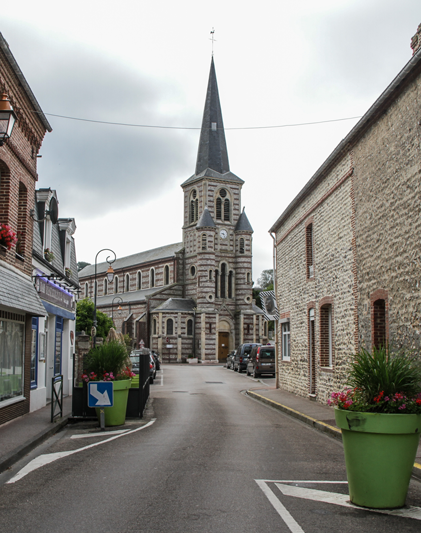
How long will it take to visit Omaha Beach?
We recommend that you allow at least half a day, as a visit to Omaha Beach is really complete if you take the time to visit the American Cemetery too. It gives a different perspective on D-Day, and offers a unique panorama of the beach below.
Otherwise, we recommend spending 2 full days here to get a comprehensive overview of all the museums and memorials. And of course, you can decide to stay longer if you want to discover other D-Day sites in Normandy.

What to do in Omaha Beach if you only have half a day or a day?
If your timing is tight, we recommend you prioritize the following activities:
- walk along the beach and observe the sculpture Les Braves,
- visit the Normandy American Cemetery,
- extend your walk to support point WN62,
- discover theOverlord Museum.
Of course, if you have more time, we recommend exploring the other sites listed in this article to complete your D-Day experience.

See our offers for organized day tours of D-Day sites in Normandy.
1. Contemplating the beach and its sculpture Les Braves
Why observe the beach and its sculpture Les Braves?
The sculpture Les Braves, a true symbol of Omaha Beach, is an important and poignant memorial. It honors the memory of the soldiers who died during the Normandy Landings in the Second World War. We were captivated by the elegance of this work of art, which blends into the natural setting lost between land and sea. The sharp shapes reminded us of the harshness of the fighting on this beach on June 6, 1944.
We recommend taking the time to observe the beach and the horizon. Can you visualize the scene? Imagine boats loaded with young fighters arriving in the distance, and planes dropping paratroopers from the sky. Next, position yourself with your back to the sea to observe the German defense points, including the top of bunker WN62. A way of imagining what the young Allied soldiers must have felt.

What you will see
Omaha Beach is one of the most photographed D-Day beaches. Created by Anilore Banon (a French artist specializing in monumental works), the sculpture was installed in 2004 for the 60th commemoration of D-Day. Les Braves is composed of 3 metal elements anchored in the sand: Les ailes de l’espoir, Debout la liberté! and Les ailes de la Fraternité. After taking the time to contemplate the work, we realized that it symbolized heaven, sea and earth, evoking the union of nations and forces that have worked for freedom. We were impressed by this sculpture, which pays tribute to the courage and sacrifice of Allied soldiers.

Practical advice
The beach is accessible free of charge all year round. We advise you to check the weather conditions before coming, as this is an entirely outdoor visit.
A must-see on any tour of the D-Day landings, the beach is very popular. If you want to get around the busy times, we recommend avoiding the summer period and other school vacations. The anniversary date of D-Day (June 6) and other major official events (such as Memorial Day, held on the last Monday in May) are also off-limits.
STAYING NEAR THE D-Day beaches
Option 1: Bayeux
The most practical option, in our opinion, is to base ourselves in the town of Bayeux. We recommend..:
- Hotel Domaine de Bayeux in an 18th century mansion – see prices, photos and availability
- see all top rated accommodations in Bayeux

Option 2: in the countryside
In the countryside around the D-Day beaches, you will find beautiful buildings with a lot of charm: farms, manors…
- Hotel Domaine d’Utah Beach – prices, pictures and availability
- Hotel Ferme de la Rançonnière – prices, pictures and availability

Option 3: next to one of the beaches
If you’re looking for a seaside holiday or are fascinated by one of the beaches, you can choose a more specific hotel:
- Hotel Villas d’Arromanches in Gold Beach Beach – prices, pictures and availability
- Hotel La Sapinière in Omaha Beach Beach – prices, pictures and availability

2. American Cemetery
Why visit Normandy American Cemetery?
A unique place of commemoration, the American Cemetery houses 9387 graves of Allied soldiers who died in the Second World War, and the names of 1557 missing soldiers are engraved in the Garden of the Missing. We found the experience both moving and rewarding. It’s a solemn, poignant tribute to the human sacrifices caused by the Normandy landings.
By observing gravestone alleys, we’ve humanized these individuals and established a connection with the deceased. It’s a place where we’ve reflected on the values of peace and gratitude to those who gave their lives for freedom. We highly recommend a visit to this cemetery, as you’ll never forget it.

What you will see
At Normandy American Cemetery, you’ll find several memorials to Allied soldiers:
- the museum, visitor center and reflecting pool,
- the belvedere,
- the alleys of the 10 grave squares,
- symbolic statues,
- the chapel and its mosaic ceiling,
- the memorial and its bronze statue,
- the Garden of the Missing.
We recommend that you consult our dedicated article for more information.

Practical advice
Schedules:
- open from 9am to 6pm from April to September,
- open from 9 a.m. to 5 p.m. from October to March.
Admission to the cemetery is free for all.
Like Omaha Beach, this is a very busy site. We advise you to avoid school vacations and official commemorations.
Consult our guided tours of the D-Day Landings.
3. Visit the Overlord Museum
Why visit the Overlord Museum?
Located near the American Cemetery and Omaha Beach, the Overlord Museum covers the period from D-Day to the liberation of Paris. Its name refers to Operation Overlord, the code name for the Allied invasion of the Normandy beaches. The collection was founded by a local who witnessed the war as a teenager. We highly recommend a visit to this museum, which shed light on the unfolding and consequences of D-Day. In fact, it’s included in our article on the 7 best D-Day museums.

What you will see
This museum is famous for:
- tanks and armored vehicles,
- its impressive collection of artifacts showing the life of soldiers (documents, souvenirs, personal effects),
- its recreations of period scenes,
- his uniforms,
- his portrait gallery.

Practical advice
Schedules:
- open from 10am to 5:30pm in February, March, October, November and December,
- open from 10am to 6:30pm in April, May and September,
- open from 9.30am to 7pm between June and August.
Price:
- full adult price: €9.50,
- Reduced price (children aged 7 to 15): €7,
- free for children under 7 and veterans.
Official website here.
Our dedicated article will be available soon.
4. Discover bunker WN62
Why explore the WN62 fulcrum?
Continuing along Omaha Beach towards Colleville-sur-Mer beach, you’ll come across the road to bunker WN62. Perched on a promontory high above the vast expanse of sand, it faces the sea. We recommend a visit to complete your WWII-themed tour. This immersion in the heart of a German defense point that was supposed to counter the Normandy Landings in June 1944 left a lasting impression on us. We suggest you use your imagination, and try to put yourself in the shoes of a soldier lurking in a bunker, watching the enemy on the horizon. How were they supposed to feel?

What you will see
At observation post WN62, you’ll be able to watch:
- 2 bunkers and tobrouks for machine guns,
- shelters,
- a monument to the 5th Special Engineering Brigade,
- a monument to the 1st infantry division, the Big Red One.

Practical advice
We recommend that you check the weather conditions before visiting WN62. The visit will take place almost entirely outdoors. Access to the site is free of charge.
If you’re passionate about blockhouses, we recommend a visit to the Musée du Mur de l’Atlantique in Ouistreham.
See our article on Le Grand Bunker in Ouistreham.
5. Explore the Omaha Beach Museum (Memorial)
Why visit the Omaha Beach Memorial?
Located 200m from Omaha beach, this museum is dedicated to preserving the memory of the soldiers who died during the Normandy landings. It provides an immersive, educational presentation of the events and issues at stake at this crucial moment in history. We discovered detailed information on operations, military strategies, and the lives and sacrifices of the soldiers and civilians involved.

What you will see
This memorial houses a vast collection of artifacts relating to D-Day on June 6, 1944:
- personal items,
- a short film,
- period photographs,
- reconstructions with mannequins,
- weapons,
- soldiers’ outfits,
- vehicles,
- historical documents.

Practical advice
Schedules
- open from 10am to 5pm in February, from 10am to 6pm in March, from 9:30am to 6:30pm in April, May and September, from 9:30am to 7pm from June to August, from 9:30am to 6pm in October,
- closed in November, December and January.
Price:
- full adult price: €7.50,
- children (7 to 15): €4.50.
Official website here.
Our dedicated article will be available soon.
MORE ABOUT THE D-Day sites
- The best landing sites to visit
- Visit the 5 D-Day landing beaches
- Where to stay – best hotels near the beach
- The best D-Day museums in Normandy
- German batteries to visit
- Car rental tips: Caen – Roissy-CDG – Orly – Beauvais
- Visit Omaha Beach
- Visit Utah Beach
- Visit Gold Beach
- Visit Sword Beach
- Visit Juno Beach (coming soon)
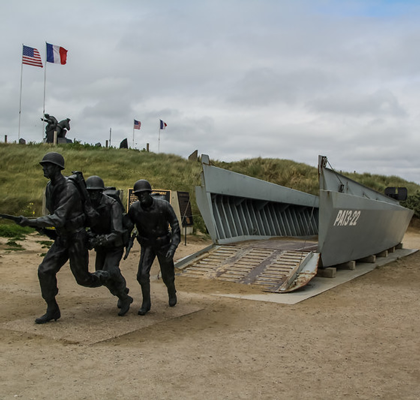
6. Discover Port Mulberry (Vierville-sur-Mer)
Why visit the artificial harbour (Omaha Beach)?
The Allies deployed this artificial harbor to facilitate the supply of troops and equipment needed during the D-Day landings. It was installed in just 2 weeks. Mulberry Harbour was a massive, ingenious infrastructure comprising floating caissons, quays, piers and other elements needed to unload cargo ships. These temporary facilities played a crucial role in the continuous supply of vital resources to Allied forces. We were able to observe the remains of this construction, and imagine the ballet of boats and soldiers at the time.

What you will see
You’ll really have to use your imagination here, as there aren’t many remnants of the artificial harbour left. However, you can still see the pontoon sunk into the sand, and wrecks of reinforced concrete caissons at low tide.

Practical advice
We recommend checking weather conditions before visiting the artificial harbour.
If you want to see the wrecks of reinforced concrete caissons, you’ll have to visit Mulberry Harbour at low tide. Otherwise, you’ll only be able to see the pontoon, which is still visible.
Subscribe to our Newsletter
- Get away from it all with Region Lovers’ beautiful destinations!
- Once a month
- Advertising-free
7. Visit the D-Day Museum (Omaha Beach)
Why visit the D-Day Museum (Omaha Beach)?
It’s a small museum with lots of character, housed in an authentic American period building. This is an interesting private collection. It is divided into 2 parts: inside and outside. As soon as we arrived, we were able to see large pieces such as an armored turret, as well as smaller ones once inside the monument.
If you want a lot of explanation, this is not the museum for you. The pieces are displayed in large, unorganized showcases. But if you’re the kind of person who likes to rummage around for surprising objects, you’ll love it.

What you will see
You’ll be able to observe:
- LCVP “Higgins Boat” barges,
- an armored turret,
- of the Mulberry’s floating bridges,
- several artillery pieces,
- a collection of rare objects,
- period reconstructions and models,
- the Goliath tank,
- the para motorcycle,
- Enigma encoder.

Practical advice
Schedules:
- open from 10:30 am to 6 pm in April, May and September,
- open from 10am to 7pm between June and August,
- closed between October and March.
Price:
- full adult price: €7,
- free for children under 8 and veterans.
Official website here.
Our dedicated article will be available soon.
8. Visit the Civil Museum (before, during and after the war)
Why visit the Civil Museum (Omaha Beach)?
For a change from weapons of war, uniforms and tanks, discover this tiny museum with a fine collection of everyday objects (from before, during and after the war). We were able to take advantage of this breathing space to discover another aspect of war. By exploring the everyday tools used by civilians during the Occupation, we’ve taken a fresh look at this period in history. Thanks to our visit to the museum, we were able to understand that life went on despite the violence of the confrontations. Unlike our grandparents, we didn’t experience life under the Occupation.

What you will see
This museum is teeming with everyday objects of all kinds:
- shoes,
- handbag,
- cradles,
- iron supply cans,
- record player,
- kitchen tools,
- car,
- bikes…

Practical advice
Schedules:
- open from 2pm to 6pm between February and September,
- open by appointment only between October and December.
Price:
- full adult price: €5.50,
- children (8 to 16): €4.50,
- free for children under 8.
Our dedicated article will be available soon.
USE OUR GUIDE TO PLAN A
DREAM TRIP TO Normandy
All the information you need for your trip:
- 8 maps that make planning easier
- 160+ pre-selected locations
- Practical advice
- 300+ photos to help you choose
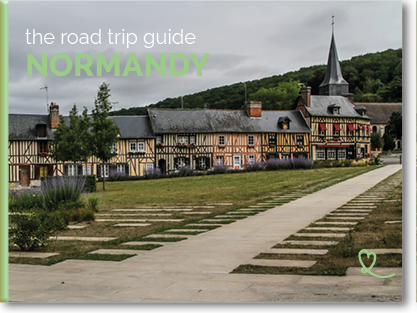
9. Discover the Big Red One Assault Museum
Why visit the Big Red One Museum (Colleville-sur-Mer)?
This is another small museum on the D-Day landings, but it has the particularity of being dedicated to the 1st American Infantry Division Big Red One. The fruit of the personal collection of the passionate Pierre-Louis Gosselin, it features unique period objects whose owner can tell you the story in detail! We particularly enjoyed the intelligence reports and his explanations of how he found certain objects.

What you will see
The museum isn’t very large, but you’ll be able to see objects relating to the 1st American Infantry Division Big Red One:
- uniforms,
- helmets,
- badges,
- equipment,
- archive photos,
- period documents.

Practical advice
Schedules:
- open every day except Tuesday, 10am to 12pm and 2pm to 6pm, March to May and September to November,
- open daily from 10am to 7pm from June to August.
Price:
- full adult price: €5,
- child rate: €3.50.
Our dedicated article will be available soon.
10. Visit the Maison de la Libération (Omaha Beach)
Why visit the Maison de la Libération (Saint-Laurent-sur-Mer)?
To round off your D-Day tour, you can visit the first house to be liberated on the morning of June 6, 1944, at Omaha Beach. It now houses a gîte, so it’s even possible to stay directly on site. This house marked by history can be visited, on request, during evenings or guided tours offered by the Association des fleurs de la Résistance. More information on the official website here.

What you’ll discover
Unfortunately, we haven’t been to the Omaha vigils (yet!), but they understand:
- a projection of the before, during and after D-Day,
- testimonies from veterans, resistance fighters and civilians told by candlelight.

Practical advice
If you’d like to sleep in the Maison de la Libération, it’s possible, but availability is limited.
See offers for the Maison de la Libération gîte.
PLAN YOUR TRIP TO Normandy
Inspiration destinations
- Deciding where to go in Normandy – the best destinations
- Our weekend ideas: best-of, romantic, unusual, seaside, luxury, family
- 16 seaside hotels in Normandy
- The most beautiful charming hotels in Normandy

Best of

Practice
- Where to stay in Normandy – best places and hotels
- See our tips for renting a car at CDG airport, Orly airport, Beauvais airport, Caen, Rouen, Bayeux…

Best things to do near Omaha Beach
La Pointe du Hoc
This coastal promontory between Omaha and Utah beaches is the ideal transition from the former to the latter. Pointe du Hoc was a key objective targeted by Allied forces during the Normandy landings on June 6, 1944. This Nazi fortified site, with its heavy guns and other defensive installations, was very difficult for the Rangers to secure. There were heavy casualties. We found it an important site, because it testifies to the Allies’ deep-seated determination to do whatever it took to liberate Europe.

Battery of Longues-sur-Mer
Would you like to visit other D-Day blockhouses? Longues-sur-Mer is home to a series of German coastal batteries, set on a cliff facing the English Channel. This major structure of the Atlantic Wall played a strategic role at the time of the D-Day landings on June 6, 1944. We were shown a fire command post and 4 casemates.

La Cambe Cemetery
The German military cemetery at La Cambe was inaugurated in 1961. With over 21,000 headstones, it is very different from the Omaha Beach American Cemetery. We thought it would be interesting to compare these two sites, which ultimately share the same objective: to pay tribute to the soldiers who died in the Second World War. Even if they were enemies, they were all human beings first and foremost.

OUR ADVICE FOR RENTING A CAR IN Normandy
- Compare prices on our preferred platform: DiscoverCars – one of the best rated sites.
- Choose a car that is comfortable enough (distances can be long) but compact (some parking lots and villages are narrow).
- Think of thecomplete insurance (some roads are tortuous and narrow).
- There is a lot of demand, book it early.

Maisy Battery
Located in Grandcamp-Maisy, a 25-minute drive from Omaha Beach, this German battery was one of the key defensive positions of the Atlantic Wall during the Second World War. It remained largely unknown for decades before being rediscovered and opened to the public as a historic site in the 2000s. We were able to explore these Nazi fortifications and military installations, and discover the complex history of this forgotten defensive position.

Bayeux
We strongly recommend that you take advantage of your visit to Omaha Beach to visit Bayeux afterwards. The Normandy town is a 30-minute drive away, and is packed with treasures, including the famous Bayeux Tapestry. In fact, we’ve written a full article compiling the 12 must-do activities in the city.

Visit the other D-Day beaches: Utah, Gold, Sword, Juno
After seeing Omaha Beach, would you like to discover the other D-Day beaches? Take a look at our article on the 5 D-Day landing beaches, and our article on the best sites, and decide on your next destination. They’re all must-sees on a trip to Normandy. Their story is both heartbreaking and inspiring.
- What to do in Utah Beach (coming soon),
- What to do in Gold Beach (coming soon),
- What to do in Juno Beach (coming soon),
- What to do in Sword Beach (coming soon).

Subscribe to our Newsletter
- Get away from it all with Region Lovers’ beautiful destinations!
- Once a month
- Advertising-free
Frequently asked questions
Is Omaha Beach worth a visit?
Absolutely, it’s a must-see D-Day beach! On June 6, 1944, Bloody Omaha was the scene of fierce confrontations that resulted in very heavy casualties on both sides. This was one of the deadliest beaches on D-Day.
Can we walk on Omaha Beach?
Yes, you can walk on the beach. We advise you to walk along it, as it hides bunkers and memorials.
Can we swim at Omaha Beach?
Yes, you can swim at Omaha Beach. We recommend you keep an eye on the tide times if you want to swim in good conditions.
All our tips in this article were put into words with the help of Elisa.


